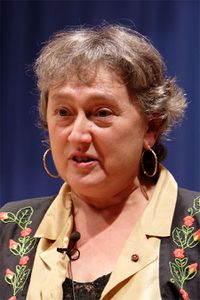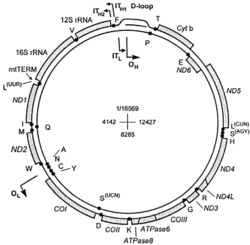Mitochondrial DNA and Type II Diabetes Mellitus
Introduction
1.1 Evolution of Mitochondrial DNA

In 1966, Lynn Margulis wrote a paper entitled “On the Origin of Mitosing Cells”. In her paper, Margulis came up with an influential theory that has been shaping modern science ever since. Although it was hard for her to publish it in magazines, she was determined that the similarity between mitochondria and bacteria was far more meaningful than sheer coincidence.That theory is now famously known as the Endosymbiosis theory. Endosymbiosis explains the origin of eukaryotes. It is suggested that the first step in the origin of eukaryotes from prokaryotes was related to survival in the new oxygen-containing atmosphere: an aerobic prokaryotic microbe (i.e. the protomitochondrion) was ingested into the cytoplasm of a heterotrophic anaerobe. This endosymbiosis became obligate and resulted in the evolution of the first aerobic amitotic amoeboid organisms. By hypothesis, some of these amoeboids ingested certain motile prokaryotes. Eventually these, too, became symbiotic in their hosts. The association of the motile prokaryote with the amoeboid formed primitive amoeboflagellates. In these heterotrophic amoeboflagellates classical mitosis evolved. The evolution of mitosis, insuring an even distribution of large amounts of nucleic acid (i.e. host chromosomes containing host genes) at each cell division, must have taken millions of years. It most likely occurred after the transition to the oxidizing atmosphere, since all eukaryotic organisms contain mitochondria and are fundamentally aerobic. [1]
When the amoeboids ingested the prokaryotes, they also took in the genetic material of the prokaryotes. This genetic material is termed as mitochondrial DNA. A few years after the publication of the paper, scientists were able to study and sequence genomes of different species. In fact, the year 2014 saw more than a thousand new mitochondrial genome sequences deposited in GenBank—an almost 15% increase from the previous year. Hundreds of peer-reviewed articles accompanied these genomes, making mitochondrial DNAs (mtDNAs) the most sequenced and reported type of eukaryotic chromosome. [2]
1.2 The Human Mitochondrial DNA
The human mitochondrial DNA was sequenced and the different genes and their products-RNAs and tRNAs- are under constant study. The human mitochondrial DNA (mtDNA) is a double-stranded, circular molecule of 16 569 bp and contains 37 genes coding for two rRNAs, 22 tRNAs and 13 polypeptides. The mtDNA-encoded polypeptides are all subunits of enzyme complexes of the oxidative phosphorylation system. [3]

The sequence shows extreme economy in that the genes have none or only a few noncoding bases between them, and in many cases the termination codons are not coded in the DNA but are created post-transcriptionally by polyadenylation of the mRNAs.[4]
1.3 Type II Diabetes Mellitus
Diabetes, type 2: One of the two major types of diabetes, the type in which the beta cells of the pancreas produce insulin but the body is unable to use it effectively because the cells of the body are resistant to the action of insulin. Although this type of diabetes may not carry the same risk of death from ketoacidosis, it otherwise involves many of the same risks of complications as does type 1 diabetes (in which there is a lack of insulin).[5] Type 2 diabetes used to be known as adult-onset diabetes, but today more children are being diagnosed with the disorder, probably due to the rise in childhood obesity. There's no cure for type 2 diabetes, but losing weight, eating well and exercising can help manage the disease. If diet and exercise aren't enough to manage your blood sugar well, you may also need diabetes medications or insulin therapy.[6]
Section 1 Genetics
Include some current research, with at least one image.
Sample citations: [7]
[8]
A citation code consists of a hyperlinked reference within "ref" begin and end codes.
Section 2 Microbiome
Include some current research, with a second image.
Conclusion
Overall text length should be at least 1,000 words (before counting references), with at least 2 images. Include at least 5 references under Reference section.
Bold
Italic
Subscript: H2O
Superscript: Fe3+
References
- ↑ [Lynn Sagan, On the origin of mitosing cells, Journal of Theoretical Biology, Volume 14, Issue 3,1967,Pages 225-IN6,ISSN 0022-5193,https://doi.org/10.1016/0022-5193(67)90079-3.(http://www.sciencedirect.com/science/article/pii/0022519367900793)
- ↑ Smith DR. The past, present and future of mitochondrial genomics: have we sequenced enough mtDNAs?. Brief Funct Genomics. 2016;15(1):47–54. doi:10.1093/bfgp/elv027
- ↑ Jan-Willem Taanman, The mitochondrial genome: structure, transcription, translation and replication, Biochimica et Biophysica Acta (BBA) - Bioenergetics, Volume 1410, Issue 2,1999, Pages 103-123, ISSN 0005-2728, https://doi.org/10.1016/S0005-2728(98)00161-3.
- ↑ Anderson, S., Bankier, A., Barrell, B. et al. Sequence and organization of the human mitochondrial genome. Nature 290, 457–465 (1981) doi:10.1038/290457a0
- ↑ Jr. WCS. Definition of Diabetes, type 2. MedicineNet. https://www.medicinenet.com/script/main/art.asp?articlekey=2976. Published January 25, 2017.
- ↑ Type 2 diabetes. Mayo Clinic. https://www.mayoclinic.org/diseases-conditions/type-2-diabetes/symptoms-causes/syc-20351193. Published January 9, 2019.
- ↑ Hodgkin, J. and Partridge, F.A. "Caenorhabditis elegans meets microsporidia: the nematode killers from Paris." 2008. PLoS Biology 6:2634-2637.
- ↑ Bartlett et al.: Oncolytic viruses as therapeutic cancer vaccines. Molecular Cancer 2013 12:103.
Edited by [Beimnet Beyene Kassaye], student of Joan Slonczewski for BIOL 116 Information in Living Systems, 2019, Kenyon College.
